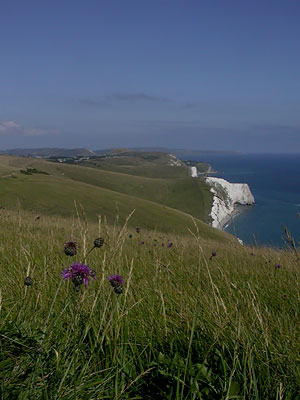We started the weekend with an evening trip to the Fleet to look for Barn Owls. No owls appeared but we had a very pleasant walk through a meadow overlooking the calm waters of the Fleet.
Saturday July 22nd
Weather: perfect butterfly-watching weather , warm sunshine all day with just one light shower.
Portland Bird Observatory, 0930
Here the warden, Martin Cade, showed us a huge variety of moths caught overnight including a Pine Hawkmoth and a Privet Hawkmoth. Martin updates the Portland Bird Observatory web site every day with a summary of the day's sightings - see www.portlandbirdobs.btinternet.co.uk. On the way to the bird observatory we found plenty of Lulworth Skippers and had a brief view of a Little Owl in the Obs Quarry.
The cliffs here held a pair of Peregrines with a single youngster and some interesting plants, namely the rare fern Sea Spleenwort and the endemic Portland Rock Sea-lavender. Whilst we were looking for Wall Lizards (which we sadly didn't see) we found a beautiful Migrant Hawker resting on the rocks.
Ferrybridge, 1300
As well as eating lunch here we found some good birds including a Sanderling, a Little Tern with young and a superb summer-plumaged Mediterranean Gull.
Penn's Weare, 1400 The car park here produced the first good find with several Small Blues behaving very well and allowing us to photograph them.

Maidenhair Fern
The return journey took us past an unusually accessible specimen of a very rare plant - the Maidenhair Fern.
Our target here was Silver-studded Blue, which we found after much searching. Easier finds were the Scarlet Tigers flying around the ivy-covered rocks and the Graylings sat on the paths.
Tadnoll Heath, 2100
Our dusk trip to see Nightjars was well-rewarded with 3 or 4 of these mysterious birds seen unusually high up in the darkening sky.

Grayling
Sunday July 23rd
Weather: Rain followed by cloud in the morning but dry and sunny again in the afternoon.
Powerstock Common, 1000
Before reaching this fabulous reserve we had to stop at Winterbourne Abbas to look at a Corn Bunting perched on wires over the road. After this several Buzzards were seen and then a Sparrowhawk flew alongside us.
With an impressive day-list already we reached Powerstock and very soon found our main target - a Silver-washed Fritillary, one of the largest insects in the UK. Increasing cloud made it difficult to find many more butterflies but a pond produced some dragonflies in compensation in the shape of a huge Emperor and a much smaller female Common Darter. The waters of the pond held several Palmate Newts seen surfacing for air and an enormous Great Crested Newt tadpole - the first ever seen on a Portland Heights weekend!
Driving east in search of sunnier conditions we ended up at Winfrith Heath, very close to where we were watching Nightjars the previous night. A great many new plants were found including the rare Oblong-leaved Sundew. Other botanical finds included Water Plantain, Great Burnet and Marsh Woundwort.

Oblong-leaved Sundew

Marsh Woundwort
Walking back to the car in hot sunshine we found more insects including a Small Copper, some smart Silver-studded Blues and another Clouded Yellow. A Common Darter was found on the path basking in the sunshine.

Small Copper

Common Darter
After a late lunch we went in search of Dark Green Fritillaries on one of the most beautiful stretches of coastline in the world. The walk from the car park to the cliff-top meadow where the butterflies live was long and hot but we did hear a Corn Bunting singing and saw several very close Skylarks. More Clouded Yellows were seen here and we finally reached the magic 25th butterfly species with a pair of Walls that were . . . on a wall. But it was the fritillaries that really stole the show with one patch of cliff-top that seemed to have a fritillary on every knapweed plant. The view was quite good as well . . .
Our last sighting of the weekend was of a young Peregrine practising hunting by chasing an easy target - a white pigeon!
Looking forward to our next trip out together,
Bob Ford
24 July 2006

view east from White Nothe
